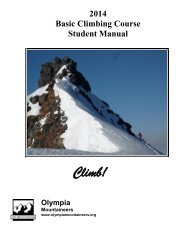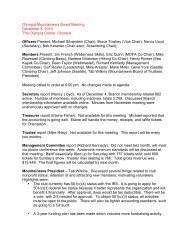Wilderness Skills - Olympia Mountaineers
Wilderness Skills - Olympia Mountaineers
Wilderness Skills - Olympia Mountaineers
You also want an ePaper? Increase the reach of your titles
YUMPU automatically turns print PDFs into web optimized ePapers that Google loves.
• White-out. Do not travel. Wait for clearing skies.<br />
• Dense fog. Do not travel. Find shelter.<br />
• Darkness. Do not travel. Improvise shelter and wait for daylight.<br />
• Lightning. Leave high, exposed areas immediately. Crouch down away from trees, caves and cliffs.<br />
• Check on the weather! It's not just the trip leader's responsibility to be aware of the weather; it is every<br />
member of the party's responsibility. Before every trip, listen to the NOAA weather report on a<br />
"weather" radio, or call the local weather phone numbers in the appendix.<br />
Weather Predicting<br />
Below is a compendium of folk sayings, common observations, and "scientific" principles useful in predicting<br />
local weather. The most reliable sources for weather predictions is NOAA Weather Radio or computerized<br />
weather data services (see phone lists ).<br />
• In the absence of any contradictory signs, predict tomorrow the weather<br />
you had today. In our area, the weather frequently occurs in seven-day<br />
patterns; today's weather will likely occur on the same day next week.<br />
• A halo around the moon or sun means rain, usually within 24 hours.<br />
• Red sky by night, sailor's delight. Red sky by morning, sailor take warning.<br />
True? The night part is about 70% accurate.<br />
• Tomorrow's weather usually comes from the west, and when the sky is<br />
clear (no water or moisture), the atmosphere scatters the light at the blue<br />
end of the spectrum, leaving mostly red. Thus, tomorrow's weather is likely<br />
to be good.<br />
• A lenticular cloud cap on Mt. Rainier, or other high peaks, is nearly always a sign of rain, probably<br />
within 24-36 hours. If Rainier is absolutely clear in the afternoon, the weather usually will hold for 24<br />
hours. High cirrus clouds usually mean precipitation possible within 24-48 hours.<br />
• The distinction between thick fog and real storm clouds is not easy to make from a canyon or valley;<br />
but, if it is raining, there is no hope of climbing above the clouds (except on very high mountains).<br />
• Rising fog is not normally associated with the onset of a storm; descending fog does indicate an<br />
approaching storm and, worse, may prevent you from seeing it until too late.<br />
• A steady fall of a barometer (while you are not climbing) is an indication that rain is coming. The greater<br />
the rate of change, the more certain the storm. In worsening weather, an altimeter reads higher, the<br />
opposite of a barometer.<br />
• A rising barometer (while you are not descending) indicates good weather. An altimeter reads lower.<br />
• You can determine the time until sunset by counting the number of your fingers between the horizon<br />
and the sun; each finger equals approximately 15 minutes.<br />
• The driest time of the year is the last 10 days of July and first 2 weeks of August.<br />
• You can estimate the temperature where you are going:<br />
o<br />
o<br />
o<br />
As elevation increases, temperature generally decreases at approximately 3.6 degrees per<br />
1,000 feet of elevation:<br />
5 degrees Fahrenheit for each 1,000 feet of elevation in dry, stable weather,<br />
3 degrees Fahrenheit for each 1,000 feet of elevation in moist weather.<br />
• If hot air rises, then why is it always cooler in the mountains? Because as hot air rises, it cools. On its<br />
way skyward, decreasing atmospheric pressure causes it to expand and, consequently, gradually grow<br />
colder. Air is warmed mainly by sunlight hitting the Earth's surface. The farther you get from the radiant<br />
<strong>Wilderness</strong> <strong>Skills</strong> Module Page 63 of 73<br />
<strong>Olympia</strong> <strong>Mountaineers</strong> - Hiking, Alpine Scrambling and Basic Climbing




